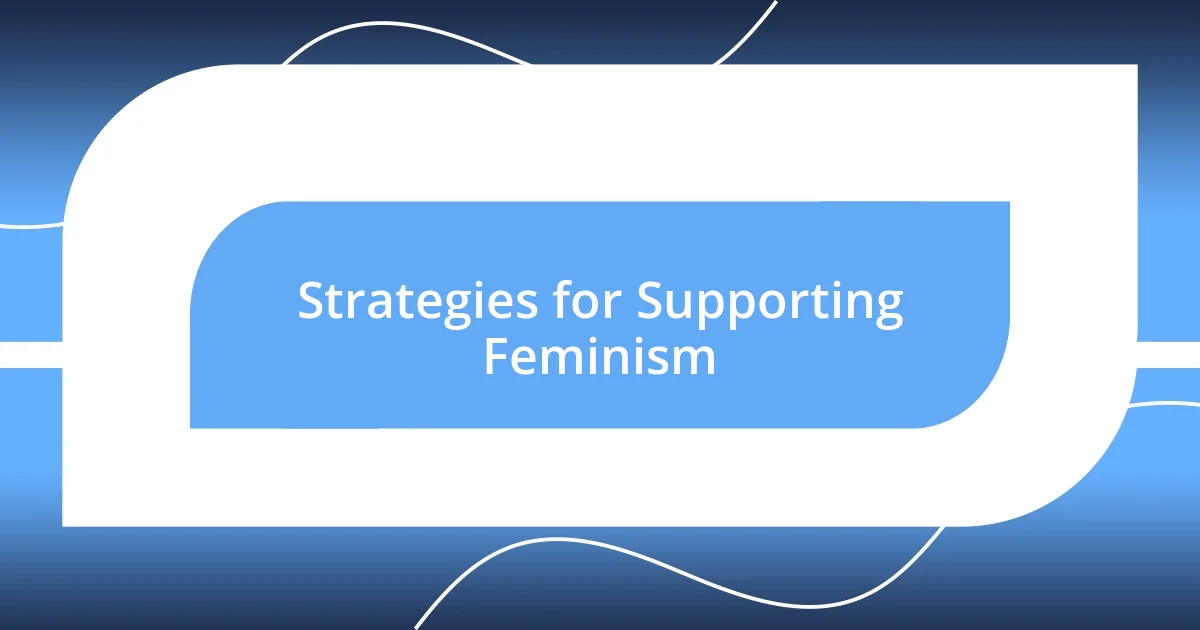Key takeaways:
- Feminism’s historical context is marked by struggles for equality, including the suffragette movement and the resilience of women from diverse backgrounds.
- Modern feminism has achieved legal rights, enhanced education for women in STEM fields, and raised awareness of gender-based violence through movements like #MeToo.
- Intersectionality and the inclusion of diverse voices are crucial for the future of feminism, alongside technology’s role in amplifying activism and the importance of male allyship.

Understanding Feminism’s Historical Context
Feminism has roots that stretch back centuries, intertwining with pivotal moments in history that reflect a struggle for equality. I often think about how my grandmother, living in a time when women had limited rights, fought hard just for the chance to vote. Isn’t it remarkable how her courage paved the way for future generations like mine to have a voice?
When we consider the suffragette movement, it’s hard not to feel a swell of admiration for women who marched and protested, facing arrest and scorn. I remember reading about Emmeline Pankhurst and how her determination inspired countless others. Can you imagine the tenacity it must have taken to stand up against a system that seemed impenetrable?
Looking back, we see that every wave of feminism didn’t emerge in a vacuum; it reacted to societal issues and injustices of the time. Personally, it struck me how the narratives of women from different backgrounds tell a broader story of resilience and strength. How can we appreciate today’s advancements without recognizing the foundational work of those who came before us?

Key Achievements of Modern Feminism
Modern feminism has celebrated several significant achievements that have reshaped society. One notable triumph is the establishment of legal rights for women, including equal pay laws and anti-discrimination legislation. I remember discussing this with my friend, a lawyer specializing in workplace issues, who shared stories of clients benefiting from these protections. It’s heartening to know that these laws empower women to advocate for themselves in the workforce.
Education also stands out as a monumental success of modern feminism. More women than ever are pursuing higher education and entering traditionally male-dominated fields like science and technology. I often reflect on my own experience in college, where I witnessed a diverse group of women excelling in engineering, and it was a beautiful sight. This shift is not just about numbers; it’s about reshaping our understanding of capability and potential based on gender.
Another important achievement is the global movement to combat gender-based violence and harassment. The #MeToo movement brought forth countless stories that highlighted the pervasive nature of these issues. Hearing firsthand accounts from my peers, I was struck by how this movement catalyzed conversations about consent and respect that were long overdue. It feels empowering to see societies push for stronger laws and awareness around such critical topics, fostering environments where women feel safe and valued.
| Achievement | Description |
|---|---|
| Legal Rights | Establishment of laws ensuring equal pay and anti-discrimination protections for women in the workplace. |
| Education | Increased access for women to higher education, leading to representation in STEM fields. |
| Gender-based Violence Awareness | The rise of movements like #MeToo advocating against harassment and promoting safe environments. |

The Impact of Intersectionality
The concept of intersectionality profoundly reshapes our understanding of feminism. As I delve into this topic, I recognize how different identities—like race, class, sexuality, and ability—intersect and create unique challenges for individuals. For instance, I recall a discussion with a friend from a marginalized community who shared her experiences of feeling overlooked within feminist circles. It made me realize that feminism isn’t a one-size-fits-all movement; it must be inclusive to truly uplift all women.
Here’s a quick look at some key aspects of intersectionality’s impact on feminism:
-
Unique Experiences: Women from various backgrounds face distinct barriers that cannot be understood through a single lens of gender alone.
-
Expanded Dialogue: Intersectionality encourages discussions that include voices often left out, enriching the feminist narrative.
-
Stronger Alliances: Recognizing shared struggles fosters solidarity among diverse groups, leading to a more powerful collective movement.
-
Policy Implications: Intersectional feminism emphasizes creating laws and policies that address the needs of all women, not just a select few.

Challenges Facing the Feminist Movement
The feminist movement faces numerous challenges that can sometimes feel overwhelming. One significant hurdle is the backlash against feminist gains, often seen in the form of political and social opposition. I recently read about a state attempting to roll back reproductive rights, which reminded me of the ongoing struggle women face in fighting for autonomy over their bodies. It’s heartbreaking to witness progress being threatened, and it leaves many wondering, how do we keep moving forward amid such resistance?
Another pressing issue is the fragmentation within the feminist movement itself. While the dialogue has expanded to include diverse voices, this has sometimes resulted in tensions among different factions. I recall attending a local feminist panel where women from various backgrounds voiced their experiences, but there were disagreements that left me pondering whether we could truly unify under a common cause. It’s crucial to bridge these gaps and understand that while our struggles may differ, our collective goal of gender equality binds us together.
Lastly, the challenge of representation remains a persistent issue. Despite recent gains, women of color, LGBTQ+ individuals, and those from lower socioeconomic backgrounds often find their voices sidelined in mainstream feminist conversations. I remember discussing this with a friend who identifies as trans; she expressed feeling invisible in many feminist spaces. It made me reflect on the importance of ensuring all women are included in the movement. How can we claim to fight for equality if we don’t uplift every voice? Each of these challenges requires our attention and commitment if we wish to create a truly inclusive feminist movement.

Feminism in Popular Culture
In popular culture, feminism has taken on many forms, reshaping how we view gender roles and expectations. One of the most compelling examples I’ve encountered is through music. When I first heard Beyoncé’s “Flawless,” it struck me not just as a catchy tune but as an anthem for empowerment. I remember feeling a rush of confidence as I sang along, recognizing how art can serve as a powerful vehicle for feminist ideals. Isn’t it incredible how songs can unite us in the fight for gender equality, often showcasing the strength and determination of women from diverse backgrounds?
Television and film also play a crucial role in promoting feminist narratives. Shows like “The Good Place” and “Marvel’s Jessica Jones” challenge societal norms while presenting complex female characters. I can’t help but smile when I think about how these characters grapple with their flaws and strengths in relatable ways. They remind me that feminism isn’t just about being strong; it’s about being real. How does it feel when we see ourselves reflected in the media? I believe it fosters a sense of belonging and validation, encouraging viewers to embrace their own journeys.
Lastly, social media has revolutionized the feminism landscape, allowing voices to emerge that were once silenced. Platforms like Twitter and Instagram have become rallying points for discussions about everything from body image to workplace equality. I vividly recall the #MeToo movement gaining traction on social media. It was eye-opening to read stories from countless women expressing their experiences. It made me think: what if our shared narratives can change societal perceptions? This collective sharing not only empowers individuals but galvanizes a community around the fight for equality, creating a space where everyone’s story matters.

Strategies for Supporting Feminism
One effective strategy for supporting feminism is to educate ourselves and others about gender issues. When I first started reading feminist literature, I found works by bell hooks and Chimamanda Ngozi Adichie to be eye-opening. Their perspectives helped me understand the complexities of feminism beyond the surface. Have you ever experienced that moment when a book shifts your understanding? It feels empowering to share that knowledge, helping others see the importance of equality in everyday life.
Another impactful approach is to actively promote and join events that celebrate women’s achievements. I remember attending a local women’s fair where I met so many inspiring individuals, each with her unique story and journey. Being part of that environment fostered a sense of camaraderie that was both uplifting and motivating. These events create connections and encourage us to celebrate the collective power of women. What if we made it a point to support at least one women-centric event a month? It could change not just our perspective but also strengthen our community ties.
Supporting female-owned businesses is a tangible way to contribute to feminism, too. The first time I bought from a local woman entrepreneur’s shop, I felt a sense of pride knowing my purchase would help her thrive. It’s a small yet significant gesture that can lead to greater economic empowerment for women. Just think: every time we choose to spend our money on women-led enterprises, we’re voting for a future where women have equal opportunities. Isn’t that a powerful way to make a difference?

Future Directions for Feminism
The future of feminism seems brighter than ever, especially with the increasing recognition of intersectionality. I remember attending a panel discussion where the speakers illuminated how race, class, and sexuality intertwine with gender issues. It struck me how crucial it is for us to elevate voices that might have been overlooked in previous feminist movements. How can we address the unique challenges faced by marginalized women if we don’t listen to their stories?
Technology will undoubtedly play a pivotal role in advancing feminist movements. Just the other day, I stumbled across a podcast dedicated to discussing feminist issues from global perspectives. Engaging with these diverse viewpoints reminded me that activism doesn’t have to be confined to the streets; it can thrive in the digital space. Isn’t it fascinating how platforms can serve as a bridge for solidarity across different communities, amplifying those voices that need to be heard the most?
Moreover, the emphasis on male allyship in feminism is gaining traction, and I find that both encouraging and necessary. Participating in discussions with male friends about gender equality has opened my eyes to their experiences and biases. I often wonder: how can we foster an environment where men feel comfortable participating in feminist dialogues? Promoting masculinity that embraces empathy and support can significantly reshape societal norms, creating an inclusive movement that benefits everyone.














